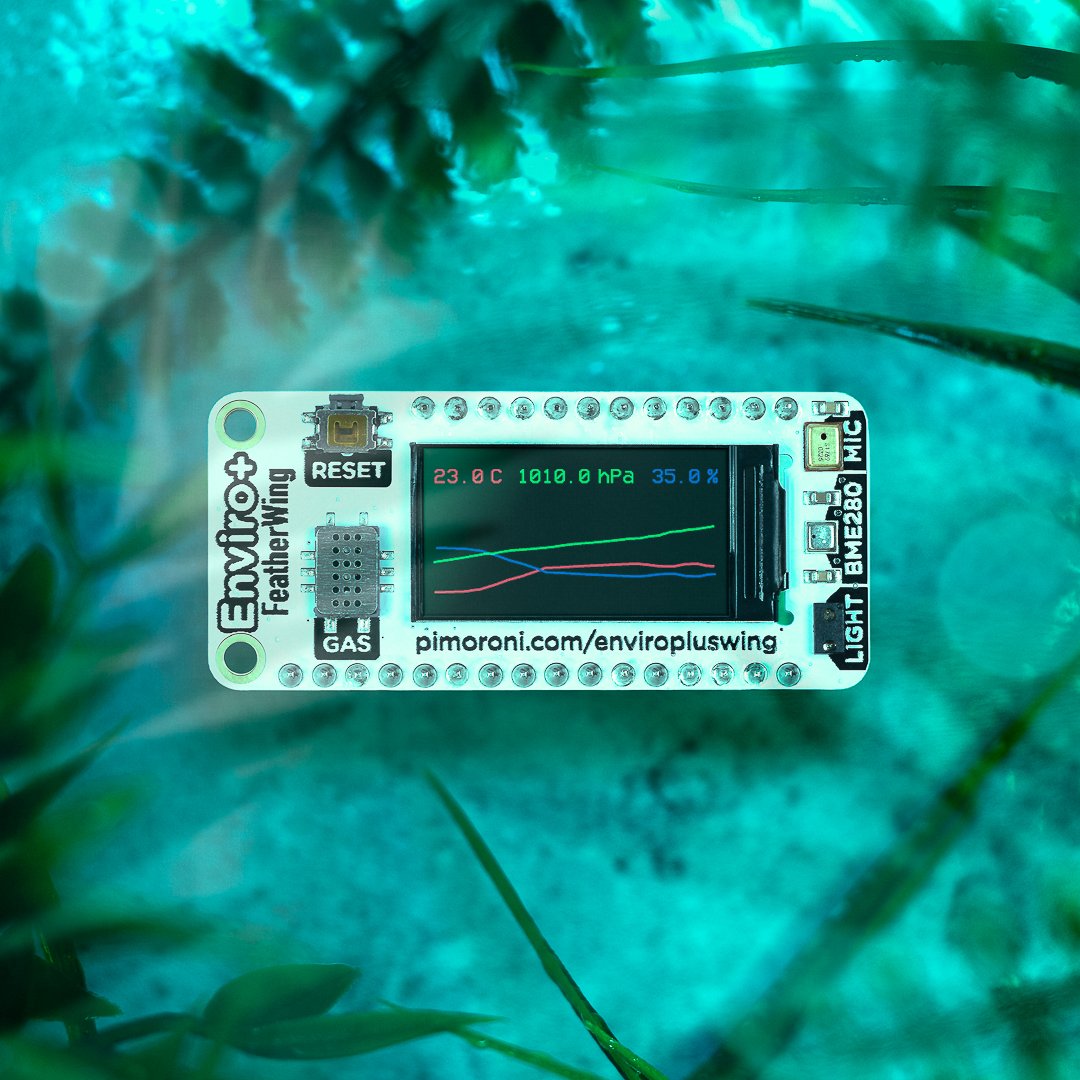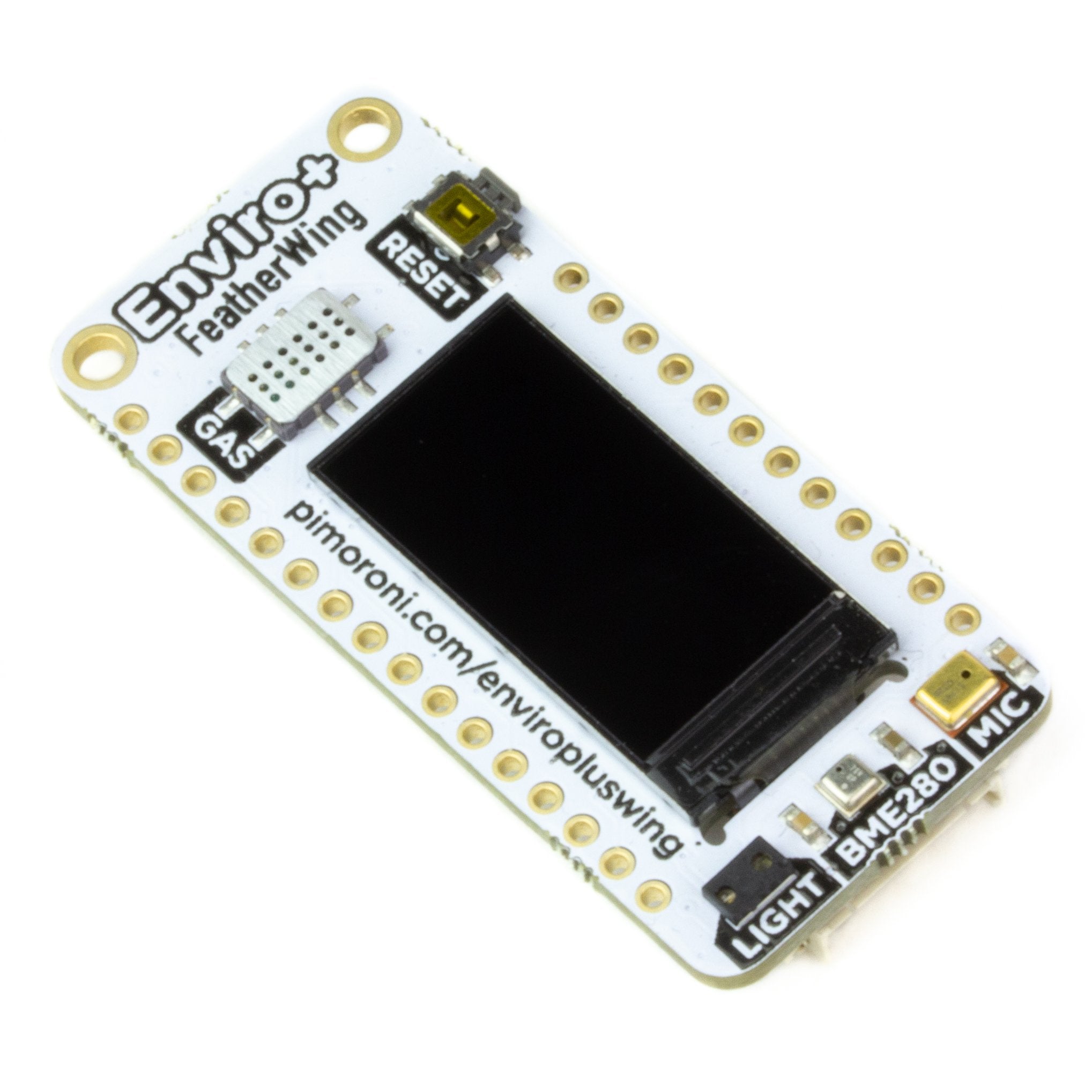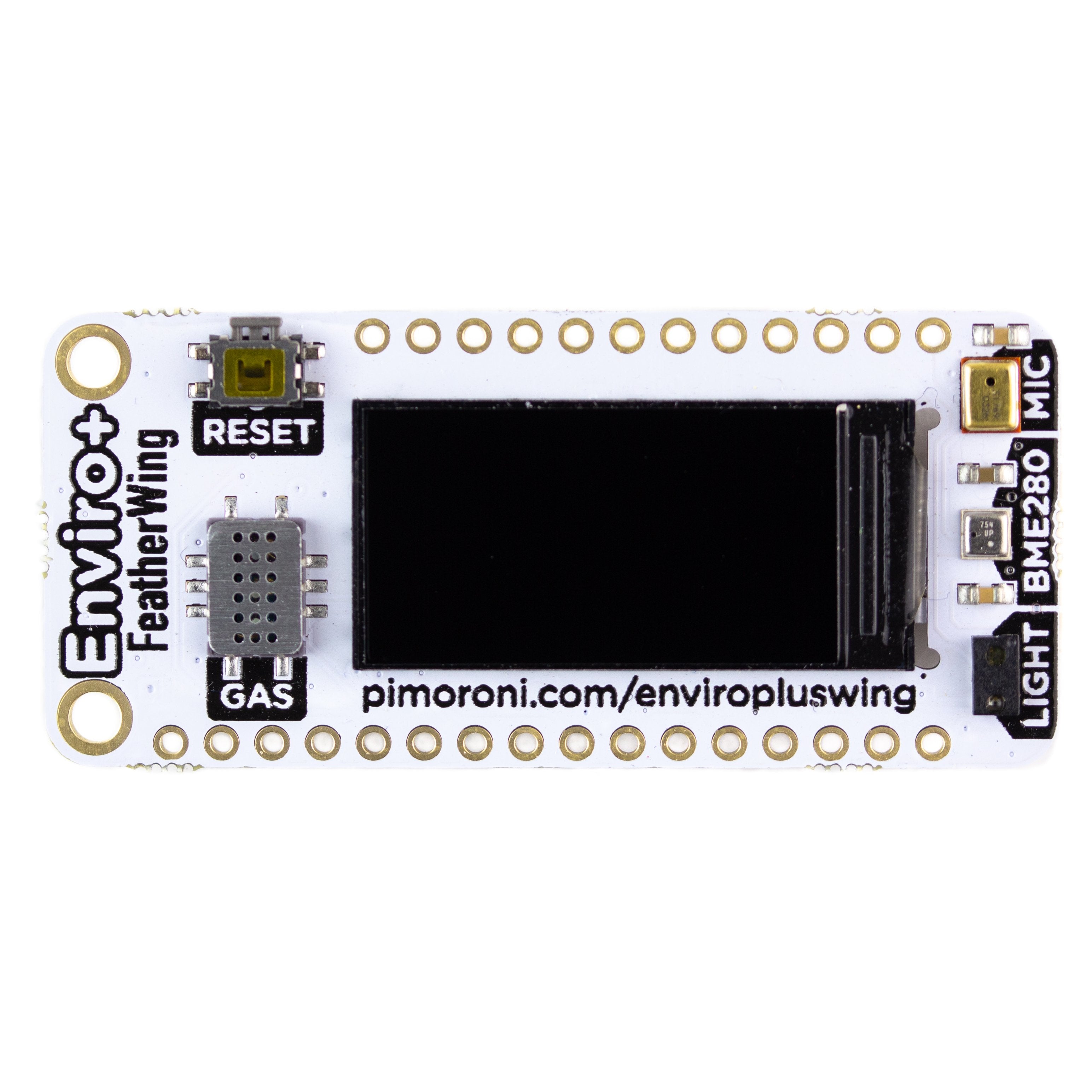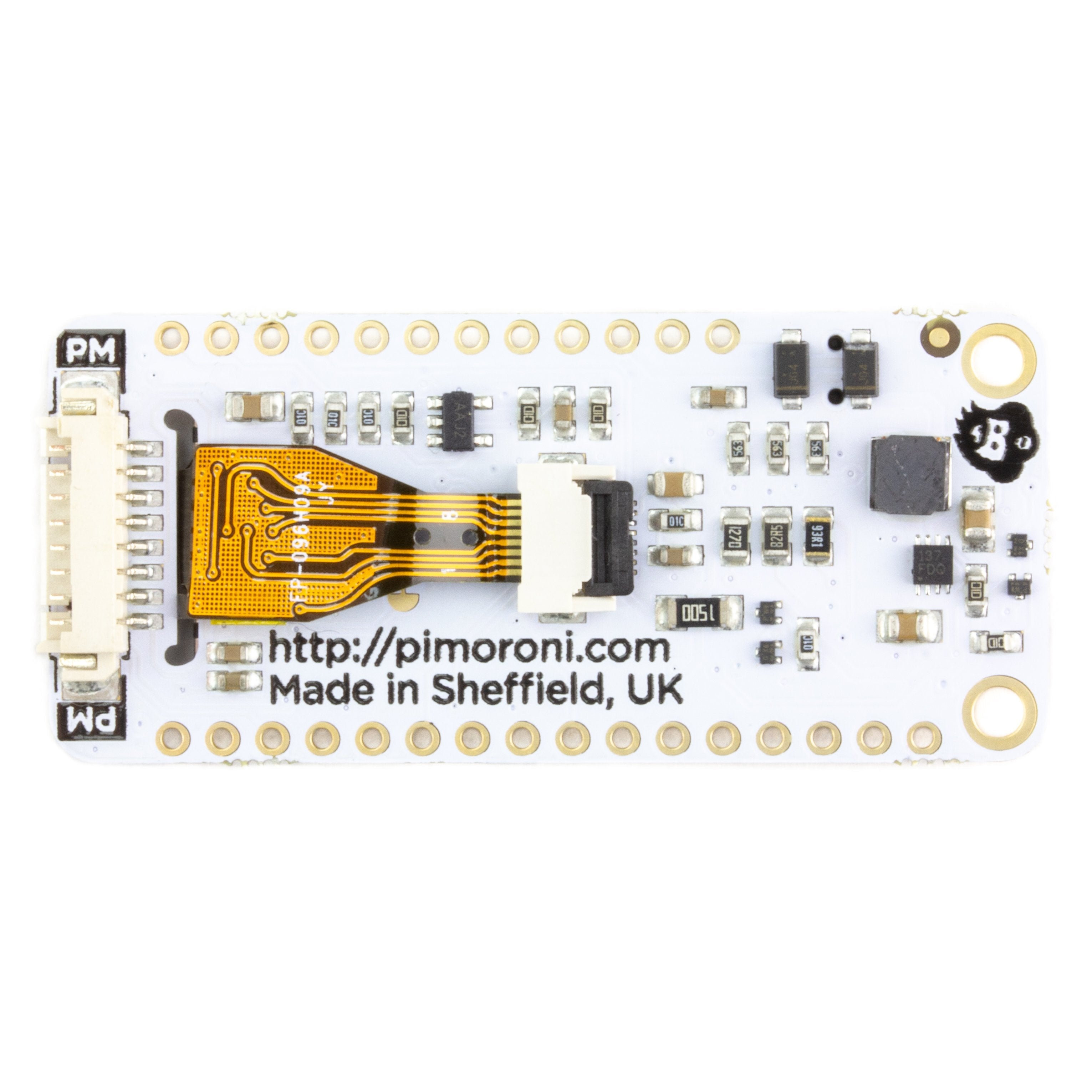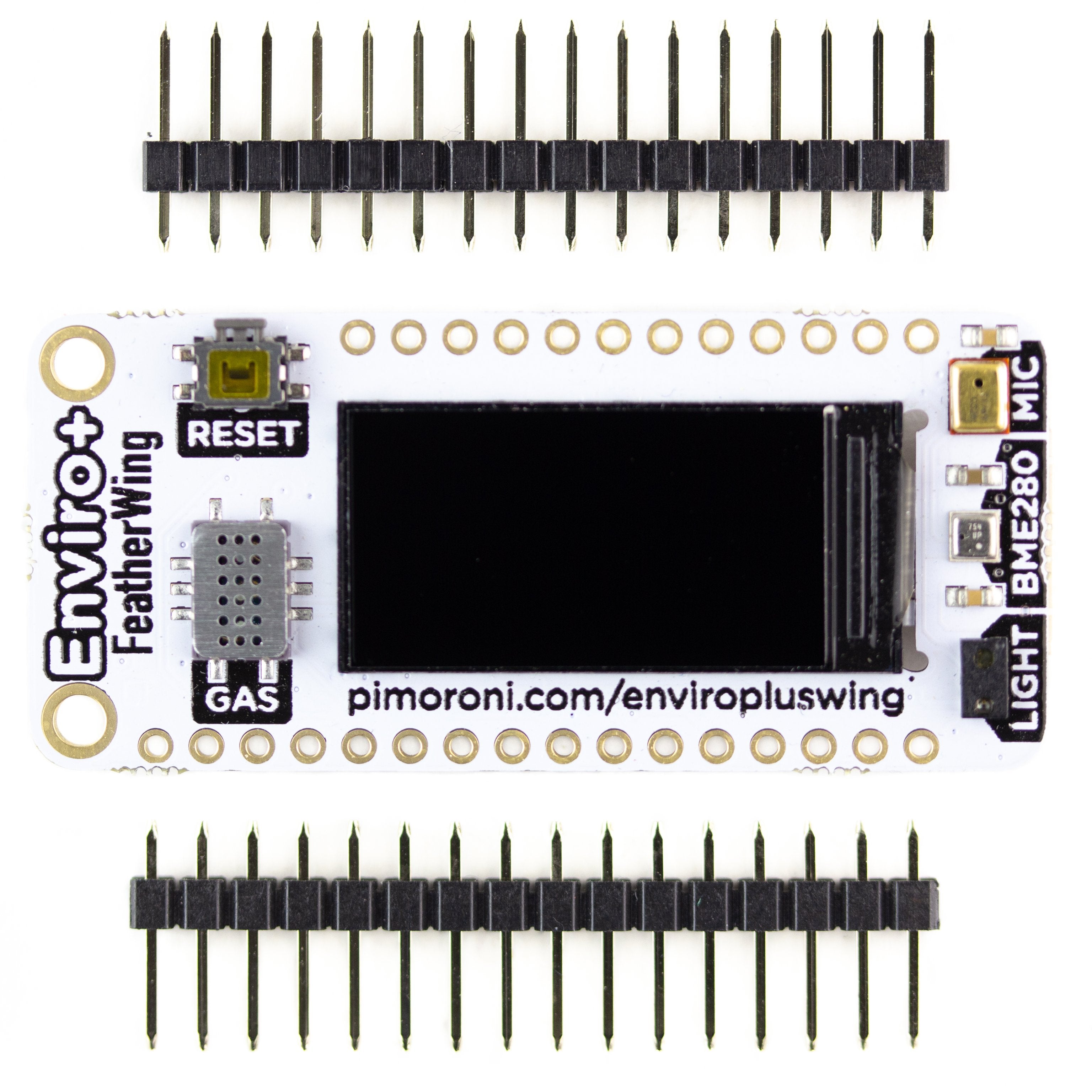Das Produkt ist End of Life (EOL) bedeutet, er wird nicht mehr hergestellt!
Kümmere dich um die Luft mit Enviro+ FeatherWing. Es ist vollgepackt mit Umweltsensoren, die Ihnen den Einstieg in die Welt der Bürgerwissenschaft ermöglichen. Überwachen Sie das Wetter, den Lichtpegel, die Lärmbelästigung und die Luftqualität in Ihrer Umgebung und tragen Sie Ihre Daten bei, um Trends in der Luftverschmutzung besser zu verstehen.
Hinweis: Sie benötigen ein Feather-Board für diesen FeatherWing. Wir empfehlen das Feder M4 Express oder Feather nRF52840 Express .
Winzig, vollgepackt mit Funktionen
Der Enviro+ FeatherWing ist nicht größer als ein paar Pfundmünzen nebeneinander, aber er ist vollgepackt mit Sensoren. Er hat alle großartigen Funktionen des größeren Enviro+ für Raspberry Pi - einen tiefen L-Sensor, einen Lichtsensor, ein Mikrofon, Gas- und Partikelsensoren* und ein wunderschönes, farbiges LCD - aber er ist für Adafruits Feather-Boards mit geringem Stromverbrauch gebaut, auf denen CircuitPython läuft.
Messen Sie Temperatur, Druck und Luftfeuchtigkeit mit dem Tiefen-L-Sensor BME280; messen Sie den Lichtpegel mit dem Licht- und Näherungssensor LTR-559; erkennen Sie eine Reihe von Schadgasen mit dem analogen Gassensor MICS6814; messen Sie den Umgebungsgeräuschpegel mit dem analogen MEMS-Mikrofon. Schließen Sie einen Feinstaubsensor PMS5003 (* separat erhältlich ) und Sie können auch die Luftqualität messen!
Enviro+ FeatherWing Merkmale
- BME280 Temperatur-, Druck- und Feuchtigkeitssensor ( datenblatt )
- LTR-559 Licht- und Näherungssensor ( datenblatt )
- MICS6814 Analoger Gassensor ( datenblatt )
- ADS1015 Analog-Digital-Wandler (ADC) ( datenblatt )
- MEMS-Mikrofon ( datenblatt )
- 0,96" Farb-LCD (160x80)
- Anschluss für Feinstaub-Sensor (PM) (separat erhältlich)
- FeatherWing-Formatbrett
- Enthält zwei 1x16-Steckerleisten
- Erfordert Löten
- CircuitPython-Bibliothek
- Abmessungen: 51x23x6,5mm (ohne aufgesetzte Köpfe)
Sorge für die Luft!
Enviro+ FeatherWing ist der kleinere Bruder des Enviro+ für Raspberry Pi, der in Zusammenarbeit mit der Universität Sheffield entwickelt wurde, mit dem Ziel, Echtzeit-Luftqualitätsdaten aus Ihrem lokalen Umfeld in offene Datenprojekte wie Luftdaten .
Der alarmierende Rückgang unserer Luftqualität ist etwas, das wir unbedingt verstehen müssen. Geräte wie Enviro+ FeatherWing ermöglichen feinkörnige, detaillierte Datensätze, anhand derer wir Veränderungen der Luftqualität im Laufe der Zeit und in verschiedenen Stadtgebieten erkennen können. Je mehr Geräte Daten beisteuern, desto besser wird die Qualität des Datensatzes.
Feinstaub (PM) besteht aus winzigen Partikeln unterschiedlicher Größe und Art, wie Staub, Pollen, Schimmelsporen, Rauchpartikel, organische Partikel und Metallionen und vieles mehr. Feinstaub macht einen Großteil dessen aus, was wir als Luftverschmutzung bezeichnen. Sie können in Größe und Menge von Feinstaubsensoren wie dem PMS5003 die Sie mit Enviro+ FeatherWing verbinden können.
Der analoge Gassensor kann verwendet werden, um qualitativ Messungen von Veränderungen in den Gaskonzentrationen, so dass man grob sagen kann, ob die drei Gasgruppen in ihrer Häufigkeit zu- oder abnehmen. Ohne Laborbedingungen oder Kalibrierung können Sie nicht sagen "die Konzentration von Kohlenmonoxid beträgt n Teile pro Million". zum Beispiel.
Temperatur, Luftdruck und Luftfeuchtigkeit können sich ebenfalls auf den Feinstaubgehalt (und die Messwerte des Gassensors) auswirken. Daher ist der BME280-Sensor am Enviro+ FeatherWing sehr wichtig, um die anderen Daten zu verstehen, die er ausgibt.
Software
Pimoroni hat eine CircuitPython-Bibliothek nur für Enviro+ FeatherWing, mit Unterstützung für alle Bits und Bobs darauf. Sie haben auch gründlich zusammen gestellte Beispiele und Dokumentation um Ihnen zu helfen, zu verstehen, wie Sie es verwenden können, und um Ihnen einige Ideen zu geben, wie Sie es weiterentwickeln können.
Lesen Sie sich die Dokumentation . Es führt Sie durch alles, was Sie in Bezug auf Bibliotheken benötigen, und erklärt Ihnen, wie Sie die verschiedenen Funktionen der Bibliothek nutzen können.
English Description
Care about air with Enviro+ FeatherWing. It's packed full of environmental sensors that'll get you started in the world of citizen science. Monitor weather, light level, noise pollution, and air quality, in your local area and contribute your data to better understand trends in air pollution.
Note: you'll need a Feather board to go with this FeatherWing. We'd recommend the Feather M4 Express or Feather nRF52840 Express.
Tiny, feature-packed
Enviro+ FeatherWing is no larger than a couple of pound coins side-by-side, but it's absolutely jam-packed with sensors. It has all the great features of the larger Enviro+ for Raspberry Pi—a weather sensor, light sensor, microphone, gas and particulate sensing*, and a gorgeous, colour LCD—but it's built for Adafruit's range of low-power Feather boards that run CircuitPython.
Measure temperature, pressure, and humidity with the BME280 weather sensor; measure light level with the LTR-559 light and proximity sensor; detect a range of pollutant gases with the MICS6814 analog gas sensor; measure ambient noise level with the analog MEMS microphone. Connect up a PMS5003 particulate matter (PM) sensor (*available separately) and you can measure air quality too!
Enviro+ FeatherWing features
- BME280 temperature, pressure, humidity sensor (datasheet)
- LTR-559 light and proximity sensor (datasheet)
- MICS6814 analog gas sensor (datasheet)
- ADS1015 analog to digital converter (ADC) (datasheet)
- MEMS microphone (datasheet)
- 0.96" colour LCD (160x80)
- Connector for particulate matter (PM) sensor (available separately)
- FeatherWing format board
- Includes two 1x16 male headers
- Requires soldering
- CircuitPython library
- Dimensions: 51x23x6.5mm (without headers attached)
Care about air!
Enviro+ FeatherWing is the smaller sibling to the Enviro+ for Raspberry Pi, developed in collaboration with the University of Sheffield, with the aim of letting you contribute real-time air quality data from your local area to open data projects like Luftdaten.
The alarming drop in our air quality is something that's really important to understand. Devices like Enviro+ FeatherWing allow fine-grained, detailed datasets that let us see shifts in air quality through time and across different areas of cities. The more devices that contribute data, the better quality the dataset becomes.
Particulate matter (PM) is made up of tiny particles that are a mix of sizes and types, like dust, pollen, mould spores, smoke particles, organic particles and metal ions, and more. Particulates are much of what we think of as air pollution. They can be measured, in size and quantity, by particulate matter sensors like the PMS5003 that you can connect to Enviro+ FeatherWing.
The analog gas sensor can be used to make qualitative measurements of changes in gas concentrations, so you can tell broadly if the three groups of gases are increasing or decreasing in abundance. Without laboratory conditions or calibration, you won't be able to say "the concentration of carbon monoxide is n parts per million", for example.
Temperature, air pressure and humidity can all affect particulate levels (and the gas sensor readings) too, so the BME280 sensor on Enviro+ FeatherWing is really important to understanding the other data that it outputs.
Software
We've built a CircuitPython library just for Enviro+ FeatherWing, with support for all the bits and bobs on it. We've also put together thorough examples and documentation to help you to understand how to use it, and to give you some ideas on how to take it further.
Have a good read through the documentation. It walks through everything you'll need in terms of libraries, and tells you how to use all of the various functions of the library.
Sicherheitsangaben
- Lesen Sie die Bedienungsanleitung sorgfältig durch, bevor Sie das Produkt verwenden.
- Stellen Sie sicher, dass alle Montage- und Installationsanweisungen des Herstellers sorgfältig befolgt werden.
- Verwenden Sie das Produkt nur für den vorgesehenen Zweck.
- Die unsachgemäße Nutzung dieses Produkts kann zu schweren Verletzungen oder Sachschäden führen.
- Nicht für Kinder unter 10 Jahren geeignet.
- Bei unsachgemäßer Verwendung besteht eine Verletzungsgefahr.
- Dieses Produkt entspricht den geltenden Sicherheitsanforderungen der Europäischen Union.
- Dieses Produkt wurde gemäß der GPSR geprüft, die sicherstellt, dass alle relevanten Sicherheitsanforderungen für Konsumgüter eingehalten werden.
Nachverfolgbarkeitsinformationen
Jedes Produkt verfügt über eines oder mehrere der folgenden Merkmale:
- Ein CE-Kennzeichen, das die Einhaltung der Sicherheits-, Gesundheits- und Umweltschutzanforderungen der Europäischen Union anzeigt.
- Eine eindeutige Serien- oder Chargennummer, um die Nachverfolgbarkeit zu gewährleisten und bei Bedarf Rückrufaktionen zu unterstützen.
- Hersteller- und Importeurangaben für den Kundensupport und Sicherheitsanfragen.
Überwachung und Berichterstattung von Vorfällen
Für den unwahrscheinlichen Fall eines Produktproblems haben wir Verfahren implementiert, um:
- Kundenbeschwerden zeitnah bearbeiten.
- Schwerwiegende Vorfälle über das EU Safety Gate/RAPEX-System melden.
- Mit den Marktüberwachungsbehörden zusammenarbeiten, um die öffentliche Sicherheit zu gewährleisten.
Kontakt:
- Email: support [@] pi3g.com
- Telefon: 0341 / 392 858 40
Dieses Produkt ist vollständig mit allen geltenden EU-Vorschriften konform, um die Sicherheit unserer geschätzten Kunden zu gewährleisten.

